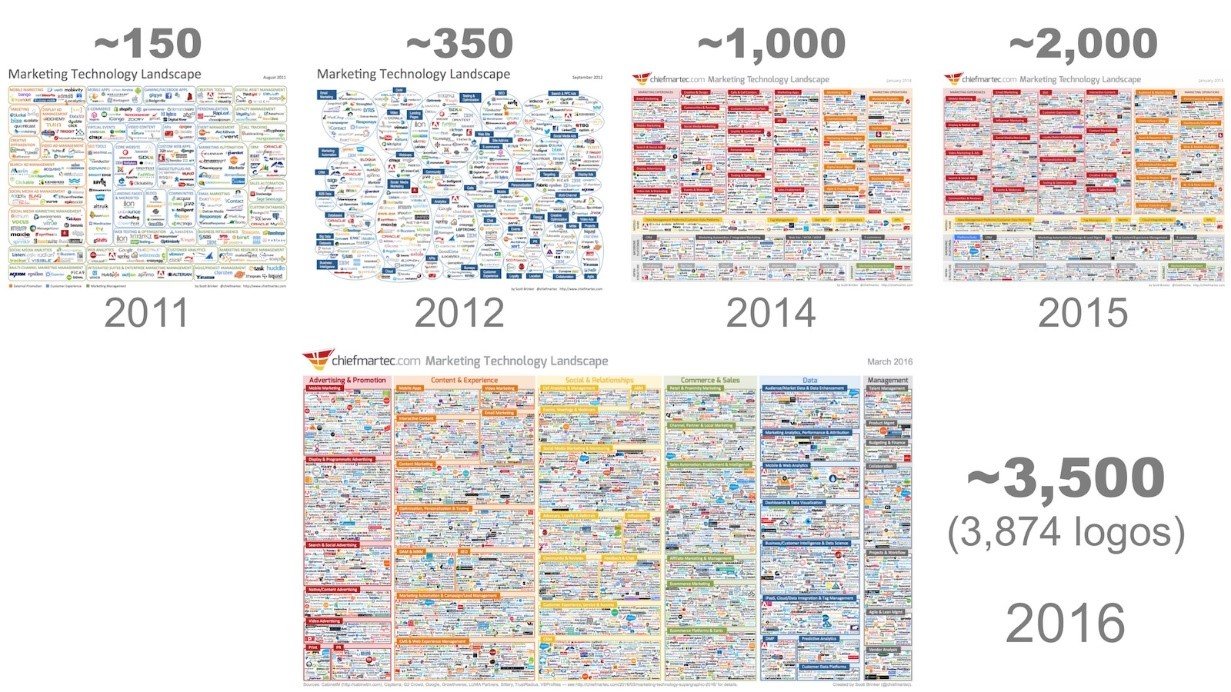The Spring MarTech Conference was held last week in San Francisco. Vocap and the team from Social123 joined what appeared to be 1,000+ attendees packed into a pretty tight space at Hilton Union Square on Monday and Tuesday. The following are some quick take-aways that Mike and I had from the conference.
2016 Chief MarTec Landscape released, explosion of Marketing Tech companies continues
During his opening keynote, MarTech conference chair Scott Brinker unveiled his new Marketing Technology Landscape – a rapidly expanding graphic for which he has received a great deal of attention over the past few years. In 2016, it appears Scott & team had the challenging task of filling the little remaining white space on the page. The landscape now features ~3,500 companies representing ~87% growth over the 2015 edition, which is remarkable considering how large it was last year (albeit not strictly an apples-to-apples comparison). You won’t be shocked to hear that a good bit of the subsequent conversation at the conference focused on a potential shake-out of this crowded field. See the full release here.
Brand messaging is getting muddled
When 3,500+ companies are competing under one sector umbrella, it’s bound to happen: the same buzzwords echo through conference halls and brand messages start to blend together into a soup of MarTech lingo (CMS, ABM, Predictive Analytics, Context, Attribution and Marketing Dashboards seem to be a few of the hot terms du jour). As Doug Pepper from Shasta Ventures pointed out during the VC panel, there is a lot more noise in 2016 and as a result, it’s much tougher to get through to CMOs than it was in 2008. It’s also tougher walking through the Conference Expo to understand the real differentiation between vendors. It is no small irony that MarTech companies, who help clients stand out from the pack and deliver compelling marketing messages, are struggling to do the same for themselves. In order to cut through all of the noise and create a lasting impression, vendors will need to break away from some of the me-too positioning and clearly differentiate their solution to marketers. Many won’t get that done, which is why a shake-out is somewhat inevitable in our opinion. With capital markets starting to tighten, 2016 could be the year we start to see some of this shake out. This is not to say we aren’t bullish on the sector. We generally agree with Ashu Garg (Foundation Capital) that spending on marketing technology will rapidly increase over the next 10 years, and this will enable new innovative Marketing Technology companies to continue to spawn and thrive.
Best-of-breed Marketing Tech stacks are here to stay
Best-of-breed vs. single provider ‘Marketing Clouds’ was a topic of some conversation on the marketing technology panel Mike moderated at the SEVC conference in Washington D.C. a couple weeks ago. The topic received a fair amount of attention out in San Francisco as well. The notion of one or a few monolith, category-killing MarTech platforms seems more distant than ever as more point solutions and targeted suites continue to emerge and marketers’ a la carte buying behavior endures. A quick look at the second annual Stackie Awards, which were announced at the conference, highlights this trend. The hub and spoke paradigm has not materialized and instead, a new model featuring multiple hubs and spokes (e.g. one hub for CRM, one for DMP, one for content management, etc.) is forming. Accordingly, the applications that play nice with the broader ecosystem clearly have an advantage in the market today. In fact, a growing number of small companies are entirely focused on being the cloud-connecting middleman between these business tools.
Agile / lean marketing is on the rise
An emerging class of technology solutions has facilitated a rapid (if not real-time) feedback loop between brands and prospects / consumers. The concept of agile / lean marketing, among others, has gained traction within marketing departments as a way of capitalizing on this trend. Agile Marketing is an approach to marketing that takes its inspiration from Agile Software Development which emphasizes continuous data collection, rapid iteration, responsive plan making and collaboration. As illustrated in the slide below, this methodology is intended to produce better results on a compounding basis versus a stair-step basis associated with the more traditional quarterly / annual optimization schedule. Look for this trend to continue to gain steam and solution providers to cater their value pitch accordingly.
 Marketers need recipes, not more ingredients
Marketers need recipes, not more ingredients
There is a growing refrain among marketing professionals that goes something like this: There are numerous MarTech solutions and even more features in the market to choose from, but what I really need is something that is turnkey and automated. Put differently, instead of navigating through various applications to analyze data and then manually executing activities, marketing teams are seeking technology that is more prescriptive and autonomous, leaving the professionals to focus on strategy rather than application management. This is a growing need for larger marketers, but even more critical for the small and medium sized marketers who typically lack the human resources to manage a large number of marketing processes.
It all starts with data
Regardless of the MarTech stack a company has assembled, one thing can make or break the whole system: data. The concept is intuitive but it’s nice to see that it’s finally getting it’s time in the spotlight. We’ve been big believers in the importance of data procurement and management as it relates to marketing efficacy, and we are excited by the disruption that is happening in the space which has historically lagged in innovation. In the interest of full disclosure, one of those disruptors is a company we invested in recently, Social123 (a premium sponsor at the MarTech event). Innovators such as Social123 are attacking legacy issues with data quality, and are also leading the charge on new marketing tech related opportunities such as data automation and analytics. As we see it, contact and company data is the gas that fuels the marketing engine – put junk in and you will get junk out. Furthermore, failing to properly manage your data on an ongoing basis is analogous to watching gunk build up in the engine.



